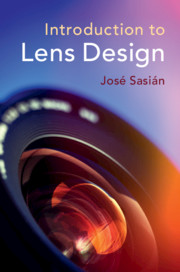Book contents
- Introduction to Lens Design
- Introduction to Lens Design
- Copyright page
- Dedication
- Epigraph
- Contents
- Preface
- 1 Introduction
- 2 Classical Imaging, First-Order Imaging, and Imaging Aberrations
- 3 Aspheric Surfaces
- 4 Thin Lenses
- 5 Ray Tracing
- 6 Radiometry in a Lens System
- 7 Achromatic and Athermal Lenses
- 8 Combinations of Achromatic Doublets
- 9 Image Evaluation
- 10 Lens Tolerancing
- 11 Using Lens Design Software
- 12 Petzval Portrait Objective, Cooke Triplet, and Double Gauss Lens
- 13 Lens System Combinations
- 14 Ghost Image Analysis
- 15 Designing with Off-the-Shelf Lenses
- 16 Mirror Systems
- 17 Miniature Lenses
- 18 Zoom Lenses
- Book part
- Glossary
- Further Reading on Lens Design
- Index
- References
5 - Ray Tracing
Published online by Cambridge University Press: 23 September 2019
- Introduction to Lens Design
- Introduction to Lens Design
- Copyright page
- Dedication
- Epigraph
- Contents
- Preface
- 1 Introduction
- 2 Classical Imaging, First-Order Imaging, and Imaging Aberrations
- 3 Aspheric Surfaces
- 4 Thin Lenses
- 5 Ray Tracing
- 6 Radiometry in a Lens System
- 7 Achromatic and Athermal Lenses
- 8 Combinations of Achromatic Doublets
- 9 Image Evaluation
- 10 Lens Tolerancing
- 11 Using Lens Design Software
- 12 Petzval Portrait Objective, Cooke Triplet, and Double Gauss Lens
- 13 Lens System Combinations
- 14 Ghost Image Analysis
- 15 Designing with Off-the-Shelf Lenses
- 16 Mirror Systems
- 17 Miniature Lenses
- 18 Zoom Lenses
- Book part
- Glossary
- Further Reading on Lens Design
- Index
- References
Summary
Ray tracing originated in optics to determine the path of light. However, ray tracing is used in modern technology by many fields, such as acoustics and computer graphics. Ray tracing is at the heart of optical design. Most optical calculations are done by tracing rays of light and, therefore, for competent lens design, it is important to have an understanding about how ray tracing is performed. This chapter provides an introduction to ray tracing, to ray tracing pitfalls, and to some useful ray tracing techniques.
Information
- Type
- Chapter
- Information
- Introduction to Lens Design , pp. 44 - 53Publisher: Cambridge University PressPrint publication year: 2019
References
Further Reading
Accessibility standard: Unknown
Why this information is here
This section outlines the accessibility features of this content - including support for screen readers, full keyboard navigation and high-contrast display options. This may not be relevant for you.Accessibility Information
- 1
- Cited by
